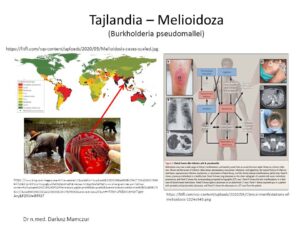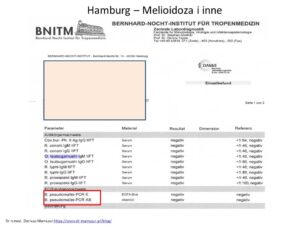Jesteśmy przed sezonem wakacyjnym. Z wyjazdów zagranicznych oprócz wrażeń i opalenizny czasem przywozimy choroby, które są pamiątką na całe życie. Niektórych z nich nie ma możliwości rozpoznania w naszych laboratoriach. Mamy hipotezę, ale potwierdzenia brak. Szukamy w laboratoriach weterynaryjnych, wojskowych z bronią biologiczną – nikt nie oznacza.
Diagnostyka trudnych przypadków daje mi możliwość współpracy z pacjentami, którzy dzięki swojej wytrwałości znajdują na świecie odpowiednie laboratoria (są to dni przeszukiwania Internetu, kontaktów ze specjalistami z krajów, w których doszło do zakażenia -np. Tajlandia), opłacania zdalnych konsultacji laboratoryjnych jak np. Szpital Medycyny Tropikalnej w Holandii – i … NIC !!.
Wśród chorób tropikalnych, o trudnej diagnostyce znajduje się już wcześniej opisywana przeze mnie na blogu Melioidoza (burkholderia pseudomallei), którą można „przywieźć” z Tajlandii.
Dlatego chcę pokazać zestaw badań w laboratorium, które wykonuje dość szeroki zestaw w zakresie chorób tropikalnych. Jest nim:
Bernhard-Nocht-Institut für Tropenmedicin
Zentrale Labordiagnostic Fachärtze für Mikrobiologie, Virologie und Infektionsepidemiologie, Prof. Dr. Stephan Günther, Prof. Dr. Dennis Tappe
Bernhard-Nocht-Str. 74 – 20359 Hamburg
Tel. +49 40 42818-211 (Ärtze), -252 Fax
 Dzięki uprzejmości i za zgodą pacjentki przedstawiam zestaw badań wykonywanych w BNITM w 2022 r.
Dzięki uprzejmości i za zgodą pacjentki przedstawiam zestaw badań wykonywanych w BNITM w 2022 r.
Wśród mało u nas znanych chorób ( zobacz mapkę rozprzestrzenienia choroby – Tsutsugamushi_Triangle) (obszar występowania wewnątrz trójkąta Iran-Japonia-Australia) chorób diagnozowanych przez to laboratorium w Hamburgu znajduje się też m.in.
Orientia tsutsugamushi (Wikipedia)
One billion people are estimated to be at risk of infection at any moment and an average of one million cases occur every year in the Tsutsugamushi Triangle.
“Orientia tsutsugamushi (from Japanese tsutsuga meaning “illness”, and mushi meaning “insect”) is a miteborne bacterium belonging to the family Rickettsiaceae and is responsible for a disease called scrub typhus in humans.[1] It is a natural and an obligate intracellular parasite of mites belonging to the family Trombiculidae Orientia tsutsugamushi causes a complex and potentially life-threatening disease known as scrub typhus. Infection starts when chiggers bite on the skin during their feeding. The bacteria are deposited at the site of feeding (inoculation), where they multiply. They cause progressive tissue damage (necrosis), which leads to formation of an eschar on the skin. Necrosis progresses to inflammation of the blood vessels, called vasculitis. This in turn causes inflammation of the lymph nodes, called lymphadenopathy. Within a few days, vasculitis extends to various organs including the liver, brain, kidney, meninges and lungs.[56] The disease is responsible for nearly a quarter of all the febrile (high fever) illness in endemic areas. Mortality in severe cases or due to improper treatment or misdiagnosis may be as high as 30-70%.[57] About 6% of infected people die untreated, and 1.4% of the patients die even with medical treatment. Moreover, the death rate can be as high as 14% with neurological problems and 24% with multi-organ dysfunction among treated patients.[58] In cases of misdiagnosis and failure of treatment, systemic complications rapidly develop including acute respiratory distress syndrome, acute kidney failure, encephalitis, gastrointestinal bleeding, hepatitis, meningitis, myocarditis, pancreatitis, pneumonia, septic shock, subacute thyroiditis, and multiple organ dysfunction syndrome.[59]
Harmful effects involving multiple organ failure and neurological impairment are difficult to treat, and can cause lifelong debilitation or be directly fatal.[59] The central nervous system is often affected and results in various complications including cerebellitis, cranial nerve palsies, meningoencephalitis, plexopathy, transverse myelitis, and Guillan-Barre syndrome.[60] Death rates due to complications can be up to 14% in brain infections, and 24% with multiple organ failure.[58] In India, scrub typhus has become the major cause of acute encephalitis syndrome, which was earlier caused mainly by a viral infection, Japanese encephalitis.[61]”.



